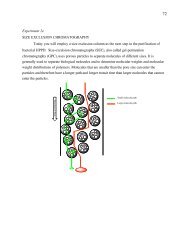Chemistry 501 Handout 14 Glycolysis, Gluconeogenesis, and the ...
Chemistry 501 Handout 14 Glycolysis, Gluconeogenesis, and the ...
Chemistry 501 Handout 14 Glycolysis, Gluconeogenesis, and the ...
Create successful ePaper yourself
Turn your PDF publications into a flip-book with our unique Google optimized e-Paper software.
Dep. of <strong>Chemistry</strong> & Biochemistry<br />
Prof. Indig<br />
<strong>Chemistry</strong> <strong>501</strong><br />
<strong>H<strong>and</strong>out</strong> <strong>14</strong><br />
<strong>Glycolysis</strong>, <strong>Gluconeogenesis</strong>, <strong>and</strong><br />
<strong>the</strong> Pentose Phosphate Pathway<br />
Chapter <strong>14</strong><br />
Lehninger. Principles of Biochemistry.<br />
by Nelson <strong>and</strong> Cox, 5 th Edition; W.H. Freeman <strong>and</strong> Company
Major pathways of glucose utilization
The first phase of glycolysis (<strong>the</strong> preparatory phase)
The second phase of glycolysis (<strong>the</strong> payoff phase)<br />
O
The two phases of glycolysis
Three possible catabolic<br />
fates of <strong>the</strong> pyruvate<br />
formed in glycolysis
1. Phosphorylation of glucose
2. Conversion of glucose 6-phosphate to fructose 6-phosphate
The phosphohexose isomerase reaction<br />
anomeric carbon
3. Phosphorylation of fructose 6-phosphate to<br />
fructose 1,6-bisphosphate
4. Cleavage of fructose 1,6-bisphosphate
The class I aldolase reaction<br />
imine
5. Interconversion of <strong>the</strong> triose phosphates<br />
Fate of <strong>the</strong> glucose carbons<br />
in <strong>the</strong> formation of<br />
glyceraldehyde 3-phosphate
6. Oxidation of glyceraldehyde 3-phosphate to<br />
1,3-bisphosphoglycerate
The glyceraldehyde 3-phosphate dehydrogenase reaction
7. Phosphoryl transfer from<br />
1,3-bisphosphoglycerate<br />
to ADP
8. Conversion of 3-phosphoglycerate to 2-phosphoglycerate
The<br />
phosphoglycerate<br />
mutase reaction
9. Dehydration of 2-phosphoglycerate to phosphoenolpyruvate
10. Transfer of <strong>the</strong><br />
phosphoryl group from<br />
phosphoenolpyruvate<br />
to ADP
Entry of<br />
glycogen,<br />
starch,<br />
disaccharides,<br />
<strong>and</strong> hexoses<br />
into <strong>the</strong> preparatory<br />
stage of glycolysis<br />
Feeder pathways<br />
for glycolysis
Feeder pathways for glycolysis
Dietary polysaccharides <strong>and</strong> disaccharides undergo<br />
hydrolysis to monosaccharides
Glycogen breakdown by glycogen phosphorylase
O<strong>the</strong>r monosaccharides enter <strong>the</strong> glycolytic pathway at several points
Conversion of galactose<br />
to glucose 1-phosphate<br />
Defects in any of <strong>the</strong> three<br />
enzymes in this phatway<br />
Cause galactosemia in humans<br />
Galactose methabolite involved in<br />
galactokinase-deficiency galactosemia
Fates of pyruvate under anaerobic conditions: Fermentation<br />
Pyruvate is <strong>the</strong> terminal electron<br />
acceptor in lactic acid fermentation<br />
acidification in muscle<br />
<strong>and</strong> blood limits <strong>the</strong><br />
period of vigorous<br />
activity<br />
no net change in<br />
NAD + or NADH
Ethanol is <strong>the</strong> reduced product in ethanol fermentation<br />
tightly bound coenzyme, thiamine pyrophosphate<br />
Industrial-scale fermentations yield a variety of<br />
common foods <strong>and</strong> industrial chemicals
The alcohol dehydrogenase reaction
Thiamine pyrophosphate (TPP) <strong>and</strong> its role in pyruvate decarboxylation
Thiamine pyrophosphate
<strong>Gluconeogenesis</strong><br />
Carbohydrate syn<strong>the</strong>sis<br />
from simple precursors
Opposing pathways of<br />
glycolysis<br />
<strong>and</strong><br />
gluconeogenesis<br />
in rat liver
Syn<strong>the</strong>sis of phosphoenolpyruvate<br />
from pyruvate
Role of biotin in <strong>the</strong><br />
pyruvate carboxylase<br />
reaction
Alternative paths from<br />
pyruvate<br />
to<br />
phosphoenolpyruvate
Citric acid intermediates <strong>and</strong> many amino acids are glucogenic<br />
Pyruvate<br />
Amino acid<br />
catabolism<br />
Citrate<br />
Isocitrate<br />
α-ketoglutarate<br />
Succinyl-CoA<br />
Succinate<br />
Fumarate<br />
Malate<br />
C.A.C.<br />
oxaloacetate<br />
C.A.C. Intermediates
Feeder pathways for glycolysis (preparatory phase)
General scheme of <strong>the</strong> pentose phosphate pathway of glucose oxidation
Oxidative reactions of <strong>the</strong><br />
pentose phosphate pathway<br />
NADP +
Nonoxidative reactions of <strong>the</strong> pentose phosphate pathway<br />
The nonoxidative phase recycles<br />
pentose phosphates<br />
to<br />
glucose 6-phosphate
The first reaction catalyzed by transketolase<br />
thiamine pyrophosphate<br />
General reaction<br />
Transfer of a two-carbon<br />
group from a ketose donor to<br />
an aldose acceptor
The reaction catalyzed<br />
by transaldolase<br />
The second reaction<br />
catalyzed<br />
by transketolase
Role of NADPH in regulating <strong>the</strong> partitioning of glucose 6-phosphate<br />
between glycolysis <strong>and</strong> <strong>the</strong> pentose phosphate pathway
Role of NADPH <strong>and</strong> glutathione (GSH) in protecting cells against<br />
highly reactive oxygen derivatives

















